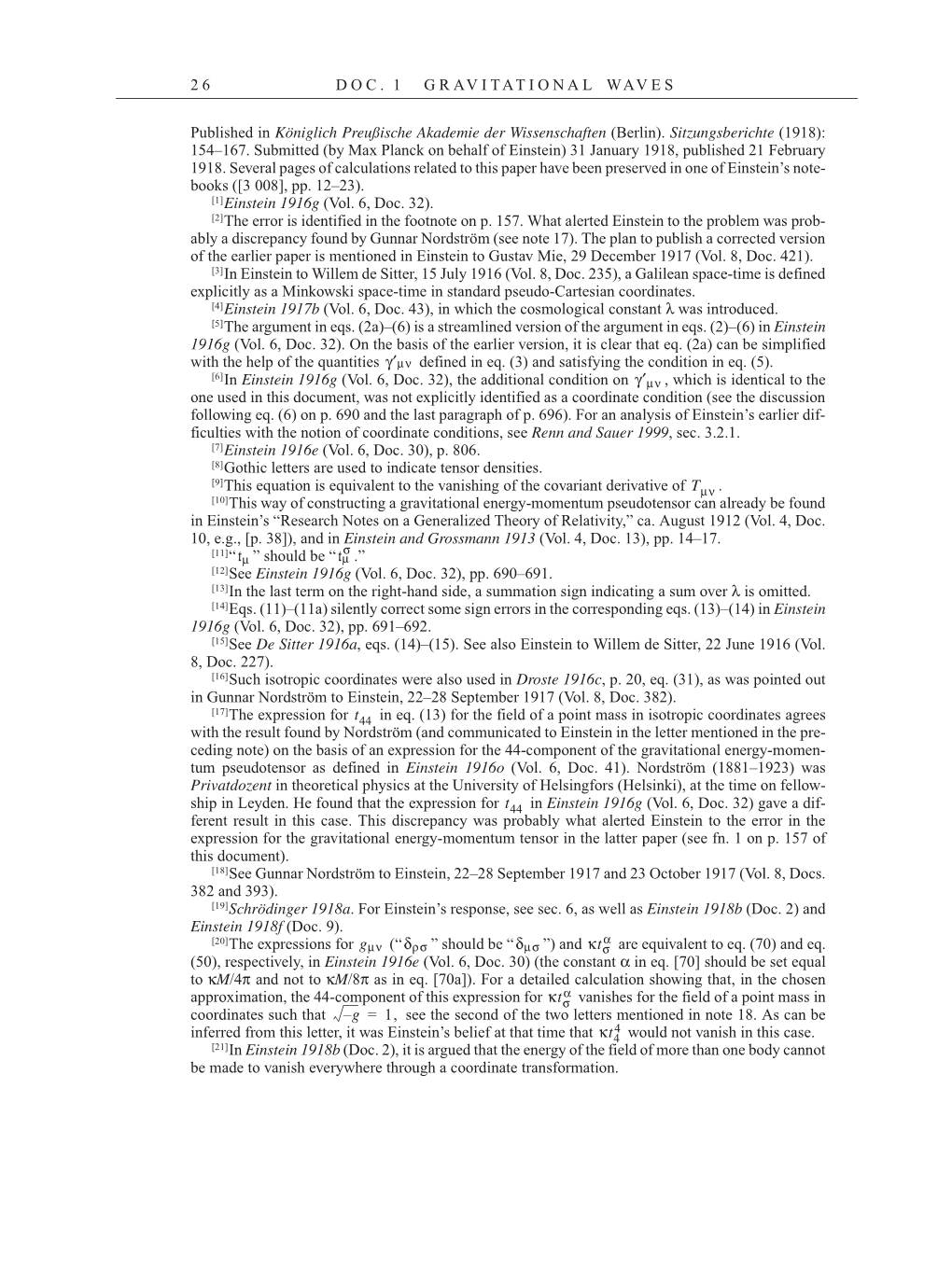2 6 D O C . 1 G R AV I TAT I O N A L WAV E S
Published in Königlich Preußische Akademie der Wissenschaften (Berlin). Sitzungsberichte (1918):
154–167. Submitted (by Max Planck on behalf of Einstein) 31 January 1918, published 21 February
1918. Several pages of calculations related to this paper have been preserved in one of Einstein’s note-
books ([3 008], pp. 12–23).
[1]Einstein 1916g (Vol. 6, Doc. 32).
[2]The error is identified in the footnote on p. 157. What alerted Einstein to the problem was prob-
ably a discrepancy found by Gunnar Nordström (see note 17). The plan to publish a corrected version
of the earlier paper is mentioned in Einstein to Gustav Mie, 29 December 1917 (Vol. 8, Doc. 421).
[3]In Einstein to Willem de Sitter, 15 July 1916 (Vol. 8, Doc. 235), a Galilean space-time is defined
explicitly as a Minkowski space-time in standard pseudo-Cartesian coordinates.
[4]Einstein 1917b (Vol. 6, Doc. 43), in which the cosmological constant λ was introduced.
[5]The argument in eqs. (2a)–(6) is a streamlined version of the argument in eqs. (2)–(6) in Einstein
1916g (Vol. 6, Doc. 32). On the basis of the earlier version, it is clear that eq. (2a) can be simplified
with the help of the quantities defined in eq. (3) and satisfying the condition in eq. (5).
[6]In Einstein 1916g (Vol. 6, Doc. 32), the additional condition on , which is identical to the
one used in this document, was not explicitly identified as a coordinate condition (see the discussion
following eq. (6) on p. 690 and the last paragraph of p. 696). For an analysis of Einstein’s earlier dif-
ficulties with the notion of coordinate conditions, see Renn and Sauer 1999, sec. 3.2.1.
[7]Einstein 1916e (Vol. 6, Doc. 30), p. 806.
[8]Gothic letters are used to indicate tensor densities.
[9]This equation is equivalent to the vanishing of the covariant derivative of .
[10]This way of constructing a gravitational energy-momentum pseudotensor can already be found
in Einstein’s “Research Notes on a Generalized Theory of Relativity,” ca. August 1912 (Vol. 4, Doc.
10, e.g., [p. 38]), and in Einstein and Grossmann 1913 (Vol. 4, Doc. 13), pp. 14–17.
[11]“ ” should be “ .”
[12]See Einstein 1916g (Vol. 6, Doc. 32), pp. 690–691.
[13]In the last term on the right-hand side, a summation sign indicating a sum over λ is omitted.
[14]Eqs. (11)–(11a) silently correct some sign errors in the corresponding eqs. (13)–(14) in Einstein
1916g (Vol. 6, Doc. 32), pp. 691–692.
[15]See De Sitter 1916a, eqs. (14)–(15). See also Einstein to Willem de Sitter, 22 June 1916 (Vol.
8, Doc. 227).
[16]Such isotropic coordinates were also used in Droste 1916c, p. 20, eq. (31), as was pointed out
in Gunnar Nordström to Einstein, 22–28 September 1917 (Vol. 8, Doc. 382).
[17]The expression for in eq. (13) for the field of a point mass in isotropic coordinates agrees
with the result found by Nordström (and communicated to Einstein in the letter mentioned in the pre-
ceding note) on the basis of an expression for the 44-component of the gravitational energy-momen-
tum pseudotensor as defined in Einstein 1916o (Vol. 6, Doc. 41). Nordström (1881–1923) was
Privatdozent in theoretical physics at the University of Helsingfors (Helsinki), at the time on fellow-
ship in Leyden. He found that the expression for in Einstein 1916g (Vol. 6, Doc. 32) gave a dif-
ferent result in this case. This discrepancy was probably what alerted Einstein to the error in the
expression for the gravitational energy-momentum tensor in the latter paper (see fn. 1 on p. 157 of
this document).
[18]See Gunnar Nordström to Einstein, 22–28 September 1917 and 23 October 1917 (Vol. 8, Docs.
382 and 393).
[19]Schrödinger 1918a. For Einstein’s response, see sec. 6, as well as Einstein 1918b (Doc. 2) and
Einstein 1918f (Doc. 9).
[20]The expressions for (“ ” should be “ ”) and are equivalent to eq. (70) and eq.
(50), respectively, in Einstein 1916e (Vol. 6, Doc. 30) (the constant α in eq. [70] should be set equal
to κM/4π and not to κM/8π as in eq. [70a]). For a detailed calculation showing that, in the chosen
approximation, the 44-component of this expression for vanishes for the field of a point mass in
coordinates such that see the second of the two letters mentioned in note 18. As can be
inferred from this letter, it was Einstein’s belief at that time that would not vanish in this case.
[21]In Einstein 1918b (Doc. 2), it is argued that the energy of the field of more than one body cannot
be made to vanish everywhere through a coordinate transformation.
γ′μν
γ′μν
Tμν
tμ tμ
σ
t44
t44
gμν δρσ δμσ κtσ α
κtσ
α
g – 1, =
κt4 4
